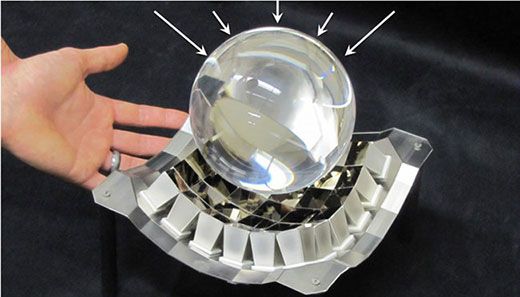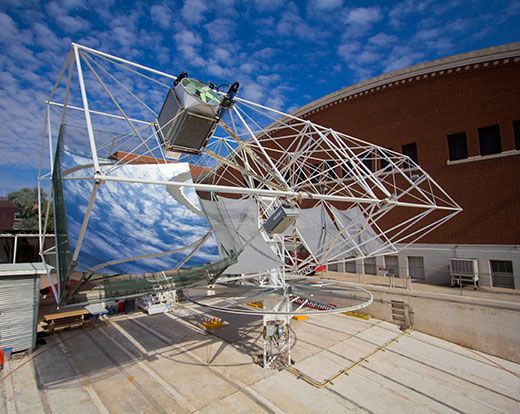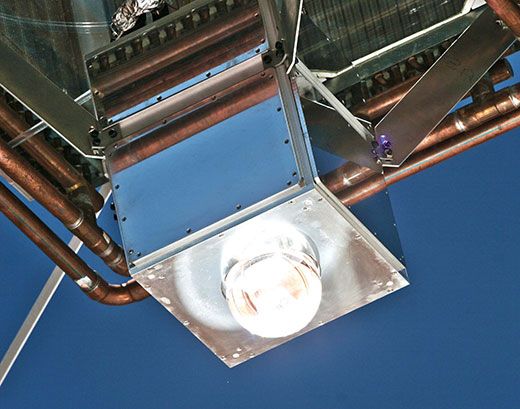An Astronomer’s Solution to Global Warming
The technology developed for telescopes, it turns out, can harness solar power
/https://tf-cmsv2-smithsonianmag-media.s3.amazonaws.com/filer/solar-energy-solar-tracker-631.jpg)
Roger Angel is an astronomer whose innovative designs for telescope mirrors have radically transformed the way we see the stars and galaxies. He developed lightweight, honeycombed mirrors for the world’s largest and most powerful telescopes, including the Large Binocular Telescope on Mount Graham in Arizona and the Giant Magellan Telescope currently under construction in Chile. He is a Regents Professor and head of the Steward Observatory Mirror Lab at the University of Arizona (UA), and a MacArthur “genius grant” Fellow. In 2010 he won the prestigious Kavli Prize for Astrophysics,. But lately he’s been thinking more about life on our own planet.
“I had been worrying about global warming,” Angel says, and he had begun contemplating solutions as audacious (and ultimately cost-prohibitive) as placing giant sun shades in space to cool the planet. But when his wife asked him, “Can’t you do something about global warming?” he got serious and began envisioning how his telescope mirrors could be used to generate clean energy. Now Angel has fashioned a system that utilizes mirrors with tiny solar cells to harness light and generate electricity, a system that has the potential to be more cost-effective than anything else on the market.
Trying to harness the power of the sun is nothing new; many companies and inventors have been analyzing the problem of how to most effectively collect, convert and use solar energy for decades. The technology of photovoltaic (PV) cells that capture the sun’s rays has improved over time, but there are still a few sticky pieces to the puzzle of producing solar electricity. Some of those issues include the amount of heat generated by existing techniques, the space needed for the solar cells and cost.
Angel is tackling a few of these problems with his new system. “It’s a complete self-contained unit that turns the light into energy and rejects the heat,” he says. Scattered around his Tucson lab are tools, scraps of metal, bits of PV cells and other pieces of the contraption. Put together, it will consist of several square mirrors attached to a large, lightweight steel frame that looks like a jungle gym. Each mirror reflects light into its own cube-shaped power conversion unit (PCU) installed above its center. The PCU is a small box with a fused silica ball on the end that faces the mirror. As the light from the sun hits the mirror, the mirror’s parabolic shape focuses the beam directly into the ball, which in turn focuses the light onto a curved matrix of 36 tiny PV cells. The cells are what convert the light into electricity.
“The cells turn about 40 percent of the light into electricity,” says Angel, noting this is highly efficient for a solar power system. His innovation also contains a cooling system using technology similar to that used for computer chips and automobile engines. “This allows the chips to stay remarkably cool: 20 degrees C above the ambient air temperature,” he says. The cooling system has the added benefit of not using any water, a resource especially precious in the deserts where many solar systems operate; recirculated coolant is used instead.
“No one has ever built a system that uses such an efficient, lightweight space frame structure to minimize the amount of steel and to hold the mirrors. Nobody’s made deeply dished glass mirrors that are practical and inexpensive like this, and nobody’s made a PCU like this,” says Angel.
Alex Cronin, a physicist at the University of Arizona who conducts research independent of Angel on PV solar cells, agrees. Angel “has optimized [this solar system] like a telescope,” Cronin says. “This is an example of stretching the envelope in a new direction. He designed it with the least amount of steel and iron. In the future we will see more of this. He’s leading the industry.”
Angel says his design has a “heritage from astronomy.” But telescopes in astronomy are used for concentrating very faint, distant light, while the mirrors here play a different role. “We’ve gone from the one extreme of making the most perfect mirrors you can think of, to the lowest-cost mirrors that are ‘good enough.’ ”
They may be cheaper, but you wouldn’t want to stand at the focal point of one of his mirrors. Angel recently tested a three-meter-wide mirror that focused sunlight on a piece of steel six millimeters thick. In 15 seconds, the beam burned a hole into the steel the size of a quarter.
In addition to the mirrors, the other critical elements of his system are the PV cells in the PCU. Rather than using the typical silicon solar cells, he takes his cue from above: “The thing that caught my eye is that recently the kind of PV cells used in space [to power the space station, for example] have been adapted for use on the ground,” he says. “Of the light that comes into them, you convert twice as much energy into electricity.” This saves money and space in the system. “Many people have noted the wonderful properties” of the newer cells, called triple-junction PV cells, “but the challenge is getting the concentrated light onto them without blowing the budget.”
With the help of the silica ball, sunlight that falls on the mirror can be focused onto an area of cells one one-thousandth the size of the mirror, and the cost of the cells becomes one-tenth as much per watt generated compared with solar panels that do not employ Angel’s technology.
Angel’s goal is to create “utility-scale” solar electricity at a price that competes with fossil fuels, something that doesn't exist today. “I think what we’re doing has a good chance. The architecture we have developed over the last few years is a new approach and is aimed specifically at getting to the low cost.”
Part of its cost–effectiveness stems from Angel’s ability to draw on manufacturing processes that are already in place. His patented and patent-pending system (covering the assembly, optics, and use of the PV cells) is simple enough that it can be manufactured in high volume, and he and a team of scientists and graduate students at the University of Arizona are researching ways to make the mass production methods even more streamlined.
Even the setting for his research and development helps cut costs. The prototype for Angel’s jungle-gym-like assembly was constructed in a deserted swimming pool behind a gym on the UA campus, a spot that once housed a satellite dish for a Tucson TV station. “This particular space has a perfect view of southern sky from dawn to dusk and is a two-minute walk from my office,” he says, and the region gets about 350 days of sunshine per year. Another benefit of being in Arizona is that “we are two to three hours behind the East Coast, which means the sun is still shining in Arizona at the time of peak demand in the East,” he says.
Angel was partly driven to develop solar power because of something he observed on Earth. His home is near a river, and he has watched the waterway decline over time. “The water table has gone down by three feet since I have been in the house,” he says. “The degradation of the river is something I see real time in front of my eyes due to overpopulation. I’ve reconciled that my beautiful river will dry up, but I don’t want to be reconciled to a planet that is doomed a miserable fate like that.”
Alaina G. Levine is a science writer based in Tucson, Arizona.


